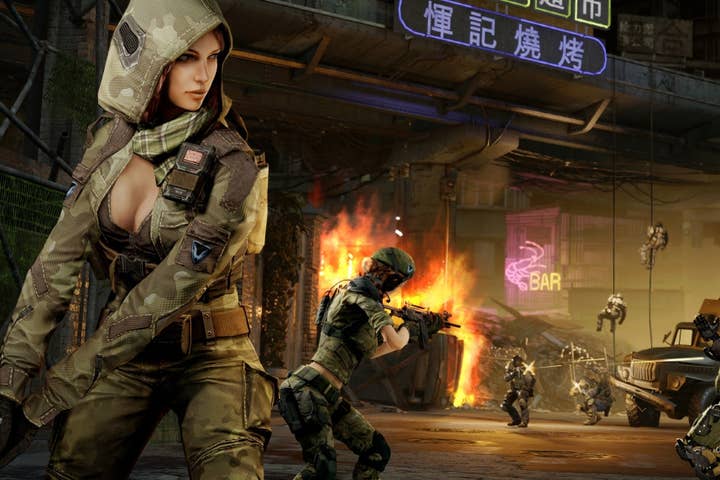Warface producer: 'sexy' female character skins result of "cultural relativism"
Howard defends Russian-led design choices for revealing uniforms
Joshua Howard, lead producer on Crytek's free-to-play shooter Warface, has defended his team's decision to implement female soldier skins with "unrealistic" proportions and revealing uniforms, saying that they're the result of player feedback and represent a certain "cultural relativism".
Speaking to Wired's Phillipa Warr, he was cautiously defensive about the choices, which led to female characters wearing uniforms with plunging necklines and exposed midriffs, reasoning that it was actually a toning down of what the game's predominantly male audience had asked for. Skins and models are also going to be different for some geographical markets, he revealed, saying that player feedback had resulted in different approaches for Russian and Chinese markets.
"The female skins [are] a good example of how we see how culturally the different regions approach the same game in different ways. The skins we're showing right now are the skins that basically came out of our Russian region. They're not what our players at first requested in the Russian region. They tended to be considerably more extreme that what we ended up shipping with."
"They're not what our players at first requested in the Russian region. They tended to be considerably more extreme that what we ended up shipping with."
Joshua Howard, lead producer, Warface.
While Crytek is clearly pandering to a market keen to preserve a decidedly unprogressive status quo, there was at least some apparent conflict between the need to appease the desires of hormonal teenagers and what Howard refers to as the studio's desire to achieve verisimilitude with actual military attire, telling Wired that, "it's our job to maintain that Warface has an authenticity to it that makes sense for us."
"They were very comfortable with the fact we have these very realistic-looking men, but they wanted the women to be not what we would think of as realistic at all. Up to and including running round in high heels which is just silly, right?"
However, that "authenticity" is clearly playing a very distant second fiddle to the need to secure the currency of players who want to ogle as they play. Male soldiers are happily ensconced in full battle dress and body armour, revealing no skin beyond a well chiselled jawline. Female snipers, however, are marching to war with a camouflage scheme rather inhibited by the exposure of acres of cleavage, while the rifle-woman is embracing the wartime spirit by making do with a tunic which falls a couple of inches short of the top of her fatigues. Clearly "authenticity" in this regard includes a reflection of the shortages of quality material in times of conflict. Both have bravely decided to eschew the body armour, ammunition pouches and face-covering helmets that the male soldiers wear to appease their cowardly fear of being shot directly in areas of exposed skin.

Whilst these particular examples have been led by feedback from Russian gamers, Howard says that not all markets demand this sort of impractical clothing from their female troops. Markets like China want their femme fatales exposed in ways which reflect a completely culturally distinct form of objectification.
"We leaned a little Russian in these characters but we're doing another set of characters for our Chinese market, for example, and those are leaning in a different direction. It's interesting to see they are also somewhat unrealistic as compared to the males but differently than the Russians. You look at the Chinese models and they're also disproportionate but in a way that's more...Chinese? I don't even know what language to use for that but they're different.
"You get these little differences you have to adjust for. The idea we were going to come up with one set of female skins across the world was clearly blown out of the water as we started to talk to more of our players and partners from different regions."
Asked directly by Warr whether there was ever any resistance to these regionally-tweaked levels of hormonal conciliation, Howard chose to dissemble slightly by comparing the representation of women to the recipe for a popular soft drink.
"Are you tempted to say, that's not right," asked Warr. "We're going to do it our way and you either get on board with this or you take your misogynistic views elsewhere?"
"Are you tempted to say, that's not right? We're going to do it our way and you either get on board with this or you take your misogynistic views elsewhere?"
Phillipa Warr, Wired
"There's a tension both ways," Howard explained, seemingly missing the real thrust of Warr's difficult to misinterpret line of questioning. "Early on we said we want to make this game appropriate for the different regions while maintaining a cohesiveness that's still Warface. Coca Cola is Coca Cola all over the world even though honestly speaking that mix is different in many different countries. There are some products that are 100 percent identical in every region of the world and that was not something we wanted to do with a shooter because people around the world play shooters very differently."
Moving swiftly on, Howard goes on to explain that costumes and cleavages aren't the only things to be locally defined - recoil rates and other gun-balancing matters are also tweaked to fit local tastes. Whether those are seen to be necessary to maintain "authenticity" is not made clear. What is clear is that, as long as the leering male is seen as the dominant demographic for pulling in cash, few studios are going to put equality ahead of equity.

